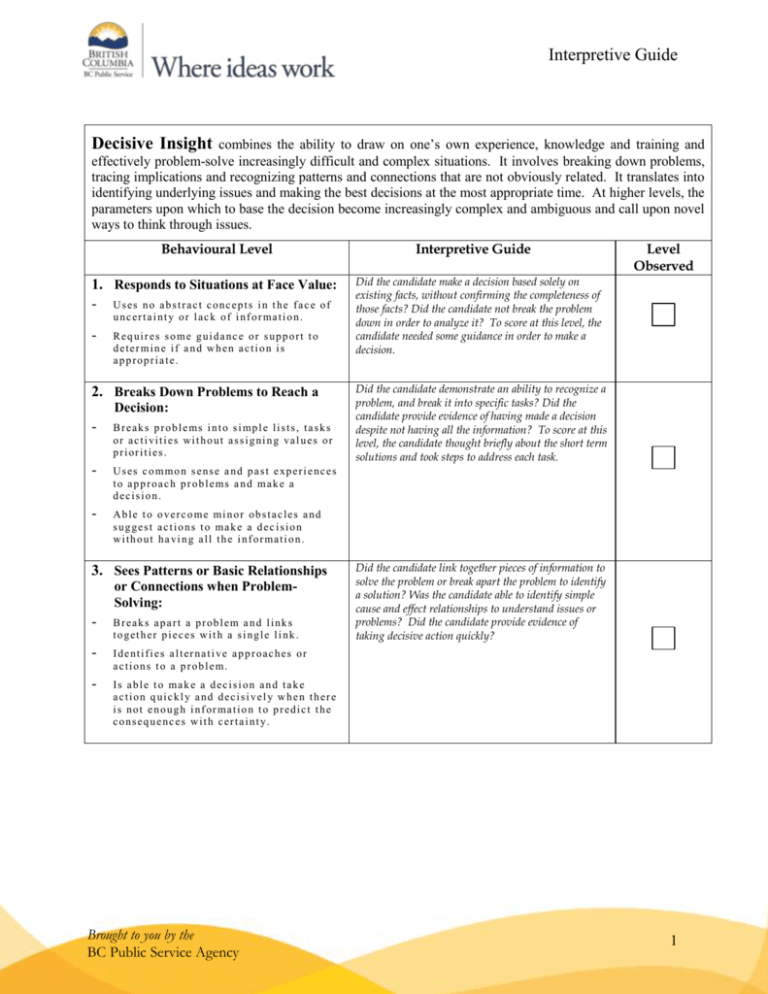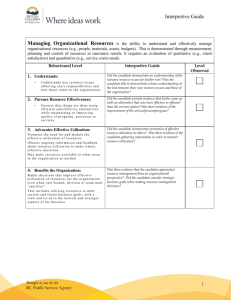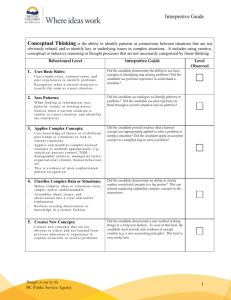Decisive Insight
advertisement

Interpretive Guide combines the ability to draw on one’s own experience, knowledge and training and effectively problem-solve increasingly difficult and complex situations. It involves breaking down problems, tracing implications and recognizing patterns and connections that are not obviously related. It translates into identifying underlying issues and making the best decisions at the most appropriate time. At higher levels, the parameters upon which to base the decision become increasingly complex and ambiguous and call upon novel ways to think through issues. Decisive Insight Behavioural Level 1. Responds to Situations at Face Value: - Uses no abstract concepts in the face of u n c e r t a i n t y o r l a c k o f i n f o r ma t i o n . - Requires some guidance or support to determine if and when action is appropriate. 2. Breaks Down Problems to Reach a Decision: - B r e a k s p r o b l e ms i n t o s i mp l e l i s t s , t a s k s o r a c t i vi t i e s w i t h o u t a s s i g n i n g va l u e s o r priorities. - Uses common sense and past experiences t o a p p r o a c h p r o b l e ms a n d m a k e a decision. - A b l e t o o v e r c o m e mi n o r o b s t a c l e s a n d s u g g e s t a c t i o n s t o ma k e a d e c i s i o n w i t h o u t h a vi n g a l l t h e i n f o r ma t i o n . 3. Sees Patterns or Basic Relationships or Connections when ProblemSolving: - Breaks apart a problem and links together pieces with a single link. - Identifies alternative approaches or a c t i o n s t o a p r o b l e m. - I s a b l e t o ma k e a d e c i s i o n a n d t a k e action quickly and decisively when there i s n o t e n o u g h i n f o r ma t i o n t o p r e d i c t t h e consequences with certainty. Brought to you by the BC Public Service Agency Interpretive Guide Level Observed Did the candidate make a decision based solely on existing facts, without confirming the completeness of those facts? Did the candidate not break the problem down in order to analyze it? To score at this level, the candidate needed some guidance in order to make a decision. Did the candidate demonstrate an ability to recognize a problem, and break it into specific tasks? Did the candidate provide evidence of having made a decision despite not having all the information? To score at this level, the candidate thought briefly about the short term solutions and took steps to address each task. Did the candidate link together pieces of information to solve the problem or break apart the problem to identify a solution? Was the candidate able to identify simple cause and effect relationships to understand issues or problems? Did the candidate provide evidence of taking decisive action quickly? 1 Interpretive Guide 4. Sees Multiple Relationships and Can Make Effective Decisions with Limited Information: - Makes multiple causal links: several potential causes of events, several consequences of actions, or multiple part chains of events. - Analyses relationships among several parts of a problem or situation. - Anticipates obstacles and thinks ahead about next steps. 5. Makes Complex Plans or Analyses and Reaches Effective Decisions in Ambiguous Situations: - U s e s s e v e r a l a n a l yt i c a l o r c r e a t i v e t e c h n i q u e s t o b r e a k a p a r t c o mp l e x p r o b l e ms i n t o c o m p o n e n t p r o b l e m s o r issues. - D r a w s o n c o mp l e x l e a r n e d c o n c e p t s w h e n e x a mi n i n g p a t t e r n s o r t r e n d s a n d recognizes underlying i s s u e s / i mp l i c a t i o n s o f d e c i s i o n s o r courses of action. - C o n s i s t e n t l y ma k e s t h e r i g h t d e c i s i o n w h e n t h e r e a r e c o mp e t i n g a n d a mb i g u o u s priorities. Brought to you by the BC Public Service Agency Did the candidate take the time to analyze the problem and what led up to the situation? Did the candidate look at the problem by breaking it down and determining causal links between the pieces? Did the candidate think of the consequences of actions and anticipate any obstacles? Did the candidate examine the present information in order to consider if any critical pieces were missing? To score at this level, the candidate not only thought about the problem and its immediate impact but also thought about the possible options and obstacles as well as considering that some information might be missing. Did the candidate use several tools or techniques to analyze the situation, and identify the relationships? Did the candidate think about the possible impact about each part of the problem and how it would impact other issue? Was the candidate able to deal with complex issues and maneuver adroitly through large amounts of data? To score at this level, the candidate has to be able to identify what other problems may be involved in the situation and must demonstrate that despite the ambiguity of the problem, an appropriate decision was made. 2









